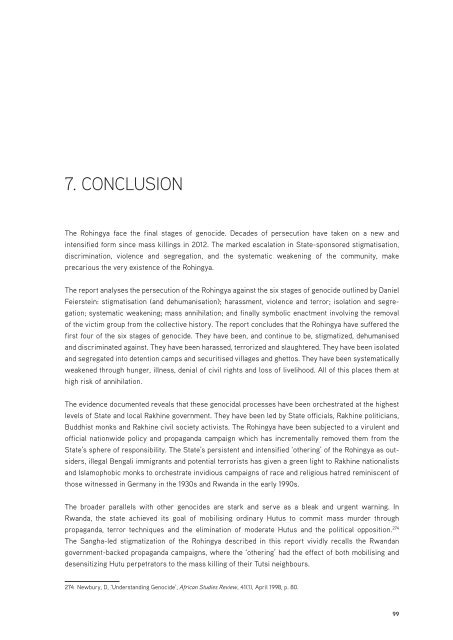Create successful ePaper yourself
Turn your PDF publications into a flip-book with our unique Google optimized e-Paper software.
7. CONCLUSION<br />
The Rohingya face the final stages of genocide. Decades of persecution have taken on a new and<br />
intensified form since mass killings in 2012. The marked escalation in State-sponsored stigmatisation,<br />
discrimination, violence and segregation, and the systematic weakening of the community, make<br />
precarious the very existence of the Rohingya.<br />
The report analyses the persecution of the Rohingya against the six stages of genocide outlined by Daniel<br />
Feierstein: stigmatisation (and dehumanisation); harassment, violence and terror; isolation and segregation;<br />
systematic weakening; mass annihilation; and finally symbolic enactment involving the removal<br />
of the victim group from the collective history. The report concludes that the Rohingya have suffered the<br />
first four of the six stages of genocide. They have been, and continue to be, stigmatized, dehumanised<br />
and discriminated against. They have been harassed, terrorized and slaughtered. They have been isolated<br />
and segregated into detention camps and securitised villages and ghettos. They have been systematically<br />
weakened through hunger, illness, denial of civil rights and loss of livelihood. All of this places them at<br />
high risk of annihilation.<br />
The evidence documented reveals that these genocidal processes have been orchestrated at the highest<br />
levels of State and local Rakhine government. They have been led by State officials, Rakhine politicians,<br />
Buddhist monks and Rakhine civil society activists. The Rohingya have been subjected to a virulent and<br />
official nationwide policy and propaganda campaign which has incrementally removed them from the<br />
State’s sphere of responsibility. The State’s persistent and intensified ‘othering’ of the Rohingya as outsiders,<br />
illegal Bengali immigrants and potential terrorists has given a green light to Rakhine nationalists<br />
and Islamophobic monks to orchestrate invidious campaigns of race and religious hatred reminiscent of<br />
those witnessed in Germany in the 1930s and Rwanda in the early 1990s.<br />
The broader parallels with other genocides are stark and serve as a bleak and urgent warning. In<br />
Rwanda, the state achieved its goal of mobilising ordinary Hutus to commit mass murder through<br />
propaganda, terror techniques and the elimination of moderate Hutus and the political opposition. 274<br />
The Sangha-led stigmatization of the Rohingya described in this report vividly recalls the Rwandan<br />
government-backed propaganda campaigns, where the ‘othering’ had the effect of both mobilising and<br />
desensitizing Hutu perpetrators to the mass killing of their Tutsi neighbours.<br />
274 Newbury, D, ‘Understanding Genocide’, African Studies Review, 41(1), April 1998, p. 80.<br />
99



